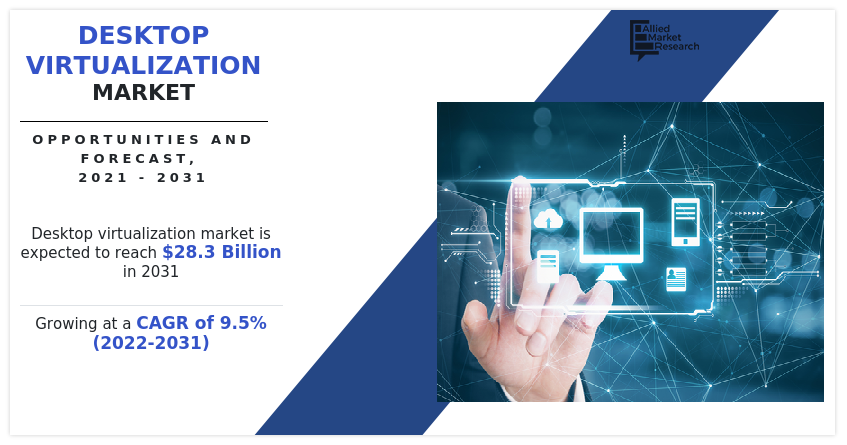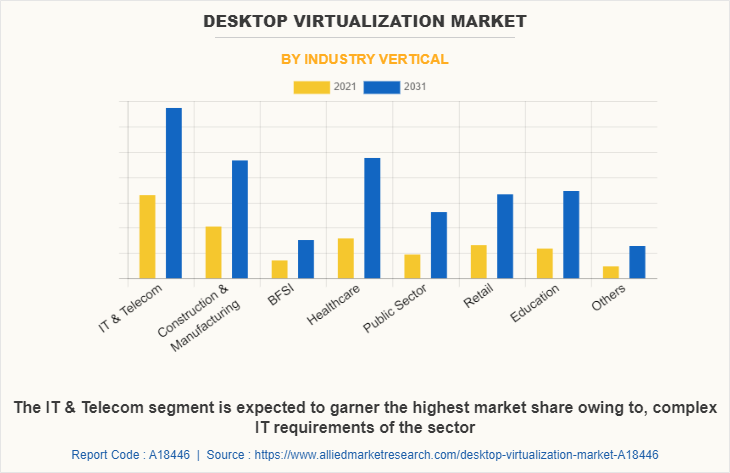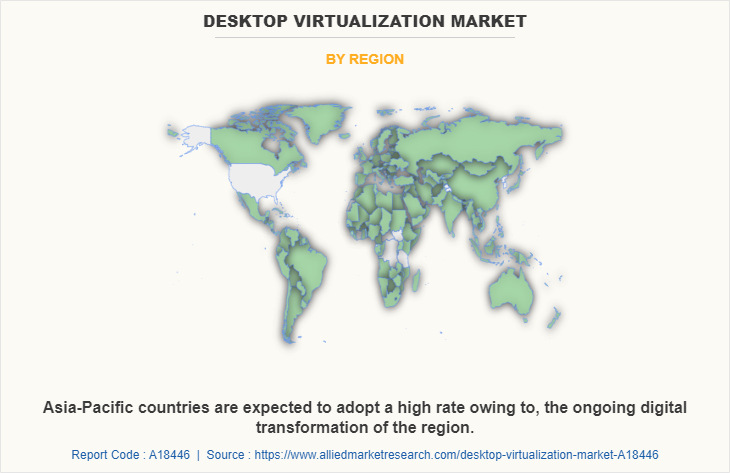Desktop Virtualization Market
P
2022
Desktop Virtualization Market Size, Share, Competitive Landscape and Trend Analysis Report, by Offering, by Type, by Enterprise Size, by Industry Vertical : Global Opportunity Analysis and Industry Forecast, 2021-2031
Desktop Virtualization Market Insights:
The global desktop virtualization market size was valued at $11.5 billion in 2021 and is projected to reach $28.3 billion by 2031, growing at a CAGR of 9.5% from 2022 to 2031.
The increase in need to increase employee efficiency and enhanced data security offered by desktop virtualization boosts the growth of the global desktop virtualization market. In addition, cost saving associated with desktop virtualization solutions positively impacts the growth of the desktop virtualization industry. However, performance and compatibility issues and expensive deployment and sign-up costs of desktop virtualization platforms are hampering the market growth. On the contrary, an increased market for workspace as a service is expected to offer remunerative opportunities for expansion of the desktop virtualization industry during the forecast period.

Desktop virtualization is typically based on a client/server model, where the organization’s chosen operating system and applications run on a server located either in the cloud or in a data center. In this model, all interactions with users occur on a local device of the user’s choosing, reminiscent of the so-called ‘dumb’ terminals popular on mainframes and early Unix systems. Desktop virtualization is also a key component of digital workspaces Virtual desktop workloads run on desktop virtualization servers which typically execute on virtual machines (VMs) either at on-premises data centers or in the public cloud.
Segment Review:
The global desktop virtualization industry is segmented on the basis of offering, type, enterprise size, industry vertical, and region. By offering, the market is bifurcated into solution and service. By type, the market is segmented into virtual desktop infrastructure (VDI), desktop-as-a-service (DaaS), and remote desktop services (RDS). By enterprise size, it is categorized into large enterprises and SMBs. By industry vertical, the market is divided into IT & telecom, construction & manufacturing, BFSI, healthcare, public sector, retail, education, and others. Region-wise, it is analyzed across North America, Europe, Asia-Pacific, and LAMEA.
The key players profiled in the desktop virtualization market analysis are Amazon Web services, Inc., Cisco Systems, Inc., Citrix Systems, Inc., Datacom Group Ltd., DXC Technology Company, Huawei Technologies Co., Ltd., International Business Machine Corporation, Ivanti, Kyndryl Inc., Microsoft Corporation, Nasstar, NetApp, NTT DATA Corporation, Nutanix, Oracle Corporation, Pure storage, Inc., Softchoice, VMware, Inc. These players have adopted various strategies to increase their market penetration and strengthen their position in the industry.
In terms of industry vertical, the IT and telecom segment holds the largest share of the desktop virtualization market, owing to the rapid adoption of desktop virtualization solutions since the outbreak of the COVID-19 pandemic. However, the healthcare segment is expected to grow at the highest rate during the forecast period, owing to the adoption of virtualized solutions for better management and enhanced security within the healthcare sector, which is anticipated to drive the desktop virtualization market growth.

Region wise, the desktop virtualization market was dominated by North America in 2021 and is expected to retain its position during the forecast period, owing to its expanding investments in new technologies such as cloud and digital technologies are anticipated to bring prominent growth in the market. However, Asia-Pacific is expected to witness significant growth during the forecast period, owing to the increase in demand from the European countries and due to its increasing technology investments which are expected to drive the desktop virtualization market in Asia-Pacific region.

The report focuses on growth prospects, restraints, and trends of the global desktop virtualization market analysis. The study provides Porter’s five forces analysis to understand impact of various factors, such as bargaining power of suppliers, competitive intensity of competitors, threat of new entrants, threat of substitutes, and bargaining power of buyers, on the global desktop virtualization market share.
Top Impacting Factors:
Growing need to increase employee efficiency
With the sudden increase in the remote workforce of corporations, post the outbreak of the COVID-19 pandemic, corporate needs to ensure that employees have seamless access to operations data round the clock to remain productive. Thus, with the implementation of desktop virtualizations, organizations can ensure that employees experience the same computing experience anywhere and anytime across the globe. For instance, the essential structure of a virtual desktop infrastructure (VDI) is centrally generated, administrated, and delivered over a network to each of its users, which reduces the computing load on local clients and improves overall efficiency.
Moreover, in this era of immense market competition, companies are focusing on boosting productivity at workplaces using various software and tools, especially desktop virtualization solutions. Employees who have access to such tools can securely access their corporate virtual desktops and data from a remote location. Moreover, VDI clients are capable of providing a richer desktop experience as compared to a typical mobile device and enable its employees to access specialized enterprise applications that they typically won’t have access to from their homes. Such factors are aiding in the development of desktop virtualization solutions during the period.
Enhanced Data Security offered by Desktop virtualization
Information security is one of the critical concerns among corporates and organizations, as cyber-threats and data breaches have become more critical than ever. For instance, in June 2020 the U.S. Department of homeland security reported a 250% increase in the number of data breaches and cyber-related attacks on federal systems over the past two years. Moreover, corporations are vulnerable to numerous attacks ranging from the infection of corporate networks by custom malware to targeted hacking along with sophisticated phishing attacks and outright tampering with intellectual property.
However, desktop virtualization solutions have evolved as one of the ideal ways to defend organizations in a better way for securing their information and managing risk, as with desktop virtualization solutions organizations can have enterprise level of security for their employees working from home. Moreover, desktop virtualization solutions play an integral role in Bring your own device (BYOD) programs, as it provides secure access to an employee’s desktop environment. Such high security offered by these solutions has fueled the rapid adoption of desktop virtualization solutions and driven desktop virtualization market growth.
Key Benefits for Stakeholders:
- This report provides a quantitative analysis of the desktop virtualization market forecast, current trends, estimations, and dynamics of the desktop virtualization market analysis from 2021 to 2031 to identify the prevailing desktop virtualization market opportunities.
- The desktop virtualization market research is offered along with information related to key drivers, restraints, and opportunities.
- Porter's five forces analysis highlights the potency of buyers and suppliers to enable stakeholders make profit-oriented business decisions and strengthen their supplier-buyer network.
- In-depth analysis of the market segmentation assists to determine the prevailing desktop virtualization market opportunities.
- Major countries in each region are mapped according to their revenue contribution to the global market.
- Market player positioning facilitates benchmarking and provides a clear understanding of the present position of the market players.
- The report includes the analysis of the regional as well as global desktop virtualization market trends, key players, market segments, application areas, and market growth strategies.
Desktop Virtualization Market Report Highlights
| Aspect | Details |
|---|---|
By Offering |
|
By Type |
|
By Enterprise Size |
|
By Industry Vertical |
|
By Region |
|
Key Market Players | VMWare |
Analyst Review
The adoption of desktop virtualization has increased by IT resources for desktop virtualization are concentrated in a data center, and resources are pooled for efficiency. The need to push OS and application updates to end-user devices is eliminated, and virtually any desktop, laptop, tablet, or smartphone can be used to access virtualized desktop applications. IT organizations can thus deploy less powerful and less expensive client devices since they are basically only used for input and output.
Key providers of the desktop virtualization market such as Amazon Web Services, Inc., Cisco Systems, Inc., and Citrix Systems, Inc. account for a significant share in the market. With the larger requirement from the corporate culture, various brands are introducing software to automate and simplify data management. For instance, in July 2022, Amazon Web Services, Inc. has launched AWS Cloud WAN. AWS Cloud WAN makes it easier to operate a global network by connecting on-premises data centers, colocation facilities, branch offices, and cloud. Customers can select their network configuration, review their network around the globe and also make their routine configuration and security automated with the help of AWS Cloud WAN.
In addition, with the increase in demand for getting instant solutions to the problem with all the resourceful insights companies such as Cisco Systems, Inc. has performed strategic product development and launch to help the end users. For instance, in April 2021, Cisco Systems, Inc. launched Unified Computing System. This new server solution works with 3rd Gen Intel Xeon Scalable processors. This new launch focuses on improving the performance, improving the security capabilities and enhancing the workload management of the customers’ complex hybrid cloud infrastructure. Since the new solution is supported by 3rd Gen Intel Xeon Scalable processors, the customers can also use these processors such as Intel SGX, Intel TME and a few more.
Furthermore, in March, 2021, Cisco Systems, Inc. has partnered with AMD. Cisco and AMD or Advanced Micro Devices plan to enhance businesses'?operations on hybrid cloud platform by providing them with better digital experiences. Cisco has launched a new platform, Unified Computing Systems which works with AMD EPYC 7003 Processors to enable businesses to manage their workloads on cloud and virtual desktop infrastructure.
Related Tags
Virtualization technology Analytics software and services Industry 40 software and servicesFrequently Asked Questions?
The global desktop virtualization market size was valued at $11.5 billion in 2021, and is projected to reach $28.3 billion by 2031
The global desktop virtualization market is expected to grow at a compound annual growth rate (CAGR) of 9.5% from 2021-2031 to reach $28.3 billion by 2031
Major key players in the desktop virtualization market research report include Amazon Web services, Inc., Cisco Systems, Inc., Citrix Systems, Inc., Datacom Group Ltd., DXC Technology Company, Huawei Technologies Co., Ltd., International Business Machine Corporation, Ivanti, Kyndryl Inc., Microsoft Corporation, Nasstar, NetApp, NTT DATA Corporation, Nutanix, Oracle Corporation, Pure storage, Inc., Softchoice, VMware, Inc.
Asia-Pacific is expected to witness significant growth during the forecast period
The increase in need to increase employee efficiency and enhanced data security offered by desktop virtualization boosts the growth of the global desktop virtualization market. In addition, cost saving associated with desktop virtualization solutions positively impacts the growth of the desktop virtualization industry.

